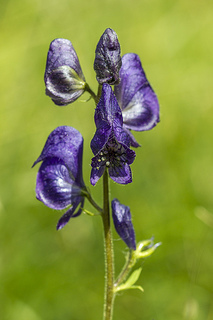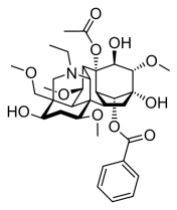Queen of Poisons. Where do you go from there? And names like that aren’t usually given away, you have to earn them. So how exactly did aconitine receive this highest honor? By being a bad ass, of course.
The genus Aconitum is comprised of over 200 species of flowering plants, and grow in damp and part-shade areas throughout North America, Europe, and Asia. They are perennials (they will grow back on their own year after year), seem to grow well in mountainous areas, and have the coolest common names.
 One such name is Wolfsbane, and it is believed it got its name from the idea that arrows dipped in an Aconitum concoction would kill wolves. Later the common name changed to Monkshood, as it resembled hoods that monks wore in the middle ages. That probably didn’t need an explanation. And today it is also referred to as Devil’s Helmet, I guess to suggest it looks like a hat and is pretty wicked. And that wickedness comes from the poison called aconitine.
One such name is Wolfsbane, and it is believed it got its name from the idea that arrows dipped in an Aconitum concoction would kill wolves. Later the common name changed to Monkshood, as it resembled hoods that monks wore in the middle ages. That probably didn’t need an explanation. And today it is also referred to as Devil’s Helmet, I guess to suggest it looks like a hat and is pretty wicked. And that wickedness comes from the poison called aconitine.
Aconitine is a secondary metabolite formed by the plant. Secondary metabolites are those chemicals produced by a plant that are not necessary to keep it alive. They have a use and can help the plant grow or develop, but most commonly they are used as defensive tools. This is the exact role aconitine plays. Aconitine is present in every part of Monkshood, from its pretty flowers right down to its dirty roots. When any part of the plant is ingested, the aconitine is absorbed through the gut and goes to work. It binds to receptors that help regulate the muscle cells’ sodium-ion channels, key components of the nervous system and cardiac cells (i.e. the heart). This action keeps the channels open, allowing sodium to flow freely into the cell. Unable to repolarize, the cells are stuck in a state of “open”, and paralysis sets in. To use a car analogy, if the valves in your car’s engine open up, but then won’t close, it’s dead in the water. Just like aconitine victims.
As unbelievable as it sounds, Monkshood has a long history of medicinal use in both Western and Eastern medicine as an analgesic (pain reliever). Many died from the treatment, as the therapeutic index is small (the amount that helps compared to the amount that hurts). But even today, some still use tinctures for their homeopathic remedies.
Clinical symptoms of exposure are localized numbness, diarrhea, and cardiac arrhythmias (uneven heart rate), leading to death. As little as 2 milligrams of aconitine is enough to kill an average human. Depending on the species, and the source, this could be less than 1 gram of Monkshood. Queen of Poisons indeed.
Historically, there have been several high profile murders involving aconitine. One of which was performed by Dr. George Henry Lamson who killed his brother-in-law with poisoned cake in 1881 in an attempt to increase his share in the family inheritance. He was taught that aconitine was undetectable, which was true at the time, but the field of toxicology is always advancing, and he was tried, found guilty, and hung.
In 2004, Canadian actor Andre Noble accidentally ate Monkshood while hiking with his aunt in Newfoundland. He became ill at his Aunt’s cabin, and died en route to the hospital.
And more recently, in 2009, Lakhvinder Cheema of London was poisoned by his jealous ex-lover, Lakhvir Kaur Singh. [He was poisoned and hospitalized once before, presumably by Ms. Singh, which is a bit telling about the psychology of poisoners, but that’s a post for a different day.] Ms. Singh entered Mr. Cheema’s home and added Aconitum leaves to some leftover curry. The curry was eaten by Mr. Cheema, his fiance, and his roomate. All became ill, but only Mr. Cheema died. Ms. Singh was convicted and sentenced to life in prison. It’s a fascinating story, and worthy of more attention at a later date.
The sad lesson is that poisons are all around us. There has to be some level of trust that your loved one won’t poison you, but respect for Nature’s Poisons helps, too.
https://naturespoisons.com/2014/02/20/aconitine-queen-of-poisons-monkshood/


Another one is datura, also called jimsonweed or devil’s snare. Also has pretty flowers. Grows in American southwest and esp. in mountain areas. I know someone who almost died eating it since his wife had no idea what it was but she thought it was an edible green.
what???????????
you dont smoke jimson weed? NO WONDER THE FAIRYS AND GNOMES IN THE YARD NEVER ANSWER WHEN I CALL!!!!!!!!
THEY CANT FLY WORTH A DANG EITHER………………
So… who’s the KING of poisons?
Can’t have a queen without a king, right?
“ARSENIC”.. LOOKITUP……
Seriously?
Cyanide is deadlier than arsenic.
I’d have gone for Sarin. 🙄